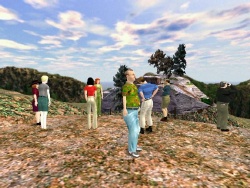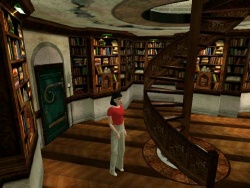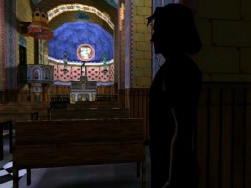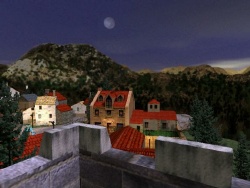|
Gabriel Knight 3: Blood of the Sacred, Blood of the Damned (Second Opinion)
 I've just finished playing the best adventure game that's ever graced my hard drive, and I'm still reeling from the experience almost a day later. We adventurers may have been skeptical that Jane Jensen could deliver the goods again, given the switch to 3D technology. After all, some recent attempts by adventure games to utilise the new medium have managed to produce a bit of eye candy (where all the budget goes), and rather little else of any substance. Well, let me assure you, spending only the first hour with Gabriel Knight 3: Blood of the Sacred, Blood of the Damned (hereafter, GK3) is enough to turn even the most hardened skeptic, like me, into a believer. I've just finished playing the best adventure game that's ever graced my hard drive, and I'm still reeling from the experience almost a day later. We adventurers may have been skeptical that Jane Jensen could deliver the goods again, given the switch to 3D technology. After all, some recent attempts by adventure games to utilise the new medium have managed to produce a bit of eye candy (where all the budget goes), and rather little else of any substance. Well, let me assure you, spending only the first hour with Gabriel Knight 3: Blood of the Sacred, Blood of the Damned (hereafter, GK3) is enough to turn even the most hardened skeptic, like me, into a believer.
But before I continue with my fanatical rantings, I suppose a little Gabriel Knight history is in order. Gabriel's first case, Sins of the Fathers, way back in 1993, had him dealing with a deadly voodoo cult. His long-suffering personal assistant, Grace Nakimura, also follows him into the second appearance, The Beast Within (1995), which saw Gabriel putting pay to a devious pack of werewolves. And you'll be pleased to know that Grace also figures heavily into the latest installment, because these two make a great team.
You see, Gabriel is a Schattenjäger (Shadow Hunter). Actually, he's the latest in a long line of Shadow Hunters, the genetic traits and necessary knowledge being passed down through each successive generation. The best way to describe these special talents that Gabriel and his forefathers possess is this: a Shadow Hunter can see things we can't. Thus, they are especially adept at dealing with supernatural phenomena in all its earthly manifestations. So, Gabriel generally supplies the instinct and the brawn, whereas Grace is the knowledgeable one who researches the background material on Gabriel's cases and provides most of the smarts when it comes to piecing together the bits of whatever enigma Gabriel is currently trying to solve. Of course, the character of Grace also supplies the romantic interest in the series, though so far she has managed to stave off Gabriel's puerile advances. As a matter of fact, watching Grace put Gabriel down in so many witty ways provides much of the humour in these games. So, it's strictly business between Grace and Gabriel at the outset of GK3...
 The prologue to GK3 is presented as a comic book that ships with the game - certainly an approach that's rather unique to the GK series. It foreshadows the dark and sinister events, often seen in Gabriel's dreams, that will occur repeatedly throughout this suspense-filled epic. Here we learn that Grace and Gabriel have been invited to visit Lord James Stewart, ostensibly to rub elbows with the European elite. Grace is delighted of the opportunity, always despairing because of Gabriel's pronounced lack of social skills. However, it appears that Lord Stewart is aware of Gabriel's less publicised talents, and has actually invited him in order to avail of his services as Schattenjäger. The prologue to GK3 is presented as a comic book that ships with the game - certainly an approach that's rather unique to the GK series. It foreshadows the dark and sinister events, often seen in Gabriel's dreams, that will occur repeatedly throughout this suspense-filled epic. Here we learn that Grace and Gabriel have been invited to visit Lord James Stewart, ostensibly to rub elbows with the European elite. Grace is delighted of the opportunity, always despairing because of Gabriel's pronounced lack of social skills. However, it appears that Lord Stewart is aware of Gabriel's less publicised talents, and has actually invited him in order to avail of his services as Schattenjäger.
Lord Stewart approaches Gabriel once the other guests have bedded down. He tells the tale of how the Stewart family has been plagued by apparent vampire visitations for centuries, and Lord Stewart is concerned that his newborn son will fall prey next. As Gabriel and Grace hold an all night vigil beside the infant, the inevitable happens - dark figures appear, Gabriel is rendered powerless in their presence, and Stewart's son is whisked away. Gabriel pursues the mysterious kidnappers onto a train, but receives a nasty knock on the head as he searches the compartments. Several hours later, a dazed Gabriel staggers off the train in the Languedoc region of southern France, and so his next adventure begins.
Rennes-le-Chateau, the small village near the train station where Gabriel loses the trail of the kidnappers, boasts a small but comfortable hotel where Gabriel is allowed to sleep off his headache. He awakens the next morning only to find himself amidst an eclectic group of people on tour. The tour group is led by Madeline Buthane, a stunning red-haired French woman, and contains, of all people, Gabriel's old buddy Detective Mosely. It turns out that this region is steeped in ancient mysticism. It's been inhabited for centuries by descendants of the Knights Templar and the Merovingians, and it's rumoured that the Holy Grail may even be buried here. The tour group is on an organised treasure hunt, and Gabriel and Grace get caught up in the action, searching for kidnappers and treasure alike.
 Now, hopefully I've managed to convey all this intrigue without telling you anything that you won't find either on the web site or the back of the box, for that would be a shame. The story and the way it slowly unravels is so good, that it deserves not to be spoiled. Likewise, I've been careful not to show any spoilers in my screenshots. Many times while I was taking the shots, I had to hold back. I'd get a really good one, only to realise: "Oh no. I can't show them that!" Now, hopefully I've managed to convey all this intrigue without telling you anything that you won't find either on the web site or the back of the box, for that would be a shame. The story and the way it slowly unravels is so good, that it deserves not to be spoiled. Likewise, I've been careful not to show any spoilers in my screenshots. Many times while I was taking the shots, I had to hold back. I'd get a really good one, only to realise: "Oh no. I can't show them that!"
Tim Curry steps in right where he left off from Sins of the Fathers, taking on the voice of Gabriel (Dean Erikson played Gabriel in The Beast Within). He's obviously quite comfortable with the role, seeing as he defined it in the first place, but he does tend to ham it up a bit at times. However, the overall effect of his deep southern drawl is quite pleasing, and his casual air helps Gabriel to defuse tense situations on many an occasion. Charity James does a great job with the character of Grace: straight to the point, lots of wit laced with cynicism. There is also a smorgasbord of accents cropping up from around the world: French, Italian, Middle Eastern, et. al., perhaps done a bit stereotypically, but all competently handled nonetheless... and then there's Mosely.
The best way I can describe the graphics in GK3 is something like: a cross between Pandora Directive and Half-Life. On the one hand, you have this marvellous 3D engine that is well suited for exploration, on the other you have the same engine producing all the cut scenes. The end result is quite effective (though we're still a long way from film quality yet), and fits on a respectable 3 CD's, unlike these 6 or even 8 CD monstrosities you get when the cut scenes are filmed with actors. Consequently, you only have to switch CD's twice in the whole game. That's progress, folks.
 GK3's interface uses a camera technique that seems strange at first, but becomes indispensable once you get used to it. It's 3rd-person, but you can move the camera to any place in an area at will. This means that you can leave Gabriel or Grace standing still, and just move the camera around to do your exploration (by holding down the left mouse button). If you need to examine something, just click on it for a close-up and Gabriel will walk over to it. The manual recommends using the interface this way, and it really does work. It only takes about a half hour to get the hang of it, and then it feels very natural. And if you leave the settings at their defaults, whenever an in-game cut scene takes place the camera will automatically be moved to the best vantage point for the scene, then returned to your control afterwards. From the above you probably caught the mention of 'Gabriel and Grace'. Yes, GK3 is a lot like The Beast Within in this respect. You take turns playing both Gabriel and Grace. GK3's interface uses a camera technique that seems strange at first, but becomes indispensable once you get used to it. It's 3rd-person, but you can move the camera to any place in an area at will. This means that you can leave Gabriel or Grace standing still, and just move the camera around to do your exploration (by holding down the left mouse button). If you need to examine something, just click on it for a close-up and Gabriel will walk over to it. The manual recommends using the interface this way, and it really does work. It only takes about a half hour to get the hang of it, and then it feels very natural. And if you leave the settings at their defaults, whenever an in-game cut scene takes place the camera will automatically be moved to the best vantage point for the scene, then returned to your control afterwards. From the above you probably caught the mention of 'Gabriel and Grace'. Yes, GK3 is a lot like The Beast Within in this respect. You take turns playing both Gabriel and Grace.
As in the earlier games, the adventure takes place over several days, and each day is split into 'timeblocks'. A timeblock might be, say: "Day One, 10am - 12pm". There are certain tasks that Gabriel or Grace must accomplish within a timeblock in order to progress to the next one. Of course, figuring out what these are can be a challenge in itself. For you point-lovers out there, the highest possible score is 965. I finished the game with 839, which means I missed quite a few things along the way. However, I intentionally didn't perform some tasks that I would have considered vital in order to test the game for 'long dead ends'; in other words, things that would mean I'd have to restore to an old game and replay from there even though I had been allowed to progress through several timeblocks in the meantime. Well, I'm delighted to report that I found nothing of the kind, and thus GK3 gets a clean report card from me. I didn't experience any bugs or lockups the whole time I played either, which says a lot for Sierra's play-testing given the immense time-to-market pressures being brought to bear these days.
GK3 has some brilliant puzzles, and most of them are of a practical nature. There were some timed, and let's say... arbitrary puzzles at the very end of the game. You know, the kind that you'd find in an 'action adventure'. I'm assuming these were put there in an effort to build up excitement for the approaching finale, but they only served to frustrate me in what was otherwise the perfect "thinking man's" game. However, it's really the only fault I can find with the entire game.
 There are a lot of scenic places for Grace and Gabriel to visit in the Rennes-le-Chateau area. Fortunately, once you are on the area map that Grace and Gabriel can travel via moped, you can click on a hint button that lets you know which spots you still need to visit to complete the current timeblock. I don't consider this cheating, because otherwise you'd have to check out perhaps a dozen places during each timeblock, when only one or two of them might actually have anything going on there. And, by the way, GK3 is reminiscent of The Last Express in this respect. There are lots of places where events are occurring independent of what Grace and Gabriel are doing. If you show up there, you'll learn something and obtain extra points. If you don't, maybe you'll find some new things the next time you play. There are a lot of scenic places for Grace and Gabriel to visit in the Rennes-le-Chateau area. Fortunately, once you are on the area map that Grace and Gabriel can travel via moped, you can click on a hint button that lets you know which spots you still need to visit to complete the current timeblock. I don't consider this cheating, because otherwise you'd have to check out perhaps a dozen places during each timeblock, when only one or two of them might actually have anything going on there. And, by the way, GK3 is reminiscent of The Last Express in this respect. There are lots of places where events are occurring independent of what Grace and Gabriel are doing. If you show up there, you'll learn something and obtain extra points. If you don't, maybe you'll find some new things the next time you play.
SIDNEY (the Schattenjäger Informational Database) makes its first appearance. It's a laptop PC whereupon Grace has concocted an ingenious menu system that allows her and Gabriel to input evidence pertaining to the case. You can scan in notes, maps, fingerprints and the like, correlate them with suspects, and even analyse text and pictures to find hidden symbols and meanings within. SIDNEY is indispensable in helping Grace and Gabriel to solve the tougher puzzles in the game. Now, about the difficulty of those puzzles... well, there were two in there that I wouldn't have been able to solve without a walkthrough. On the first one, I had the right idea but was going about it the wrong way, the other I just plain forgot an important fact that I had learned much earlier on. So beware: this is quite a difficult game. Grace will give you hints when she's logged into SIDNEY (actually, it's more like telling you what she's thinking). I'd advise taking these hints, especially during the 'puzzle to end all puzzles'. It's part of the game.
As per usual with Gabriel Knight games, this is most definitely not for kids. Heh, that's probably why I like it. While the gameplay itself might seem (mostly) innocent, the cutscenes - especially concerning Gabriel's dreams - depict some excruciatingly disturbing scenarios. This is a game that makes you contemplate the 'meaning of life', and all those other trite phrases that most aptly describe what you think about... when the lights are out... just before you fall asleep...
Copyright © Steve Metzler 1999.
All rights reserved.
|

